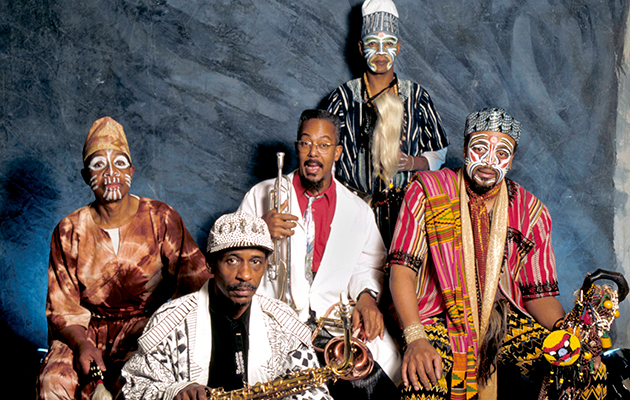For half a century now, The Art Ensemble Of Chicago have been a cartoonish presence in the usually austere world of avant-garde music. In concert, they turned free improvisation into a compelling pantomime – saxophonist Roscoe Mitchell might have vegetation growing from his hat; trumpeter Lester Bowie would wear a white lab coat; bassist Malachi Favors and drummer Don Moye would wear tribal body paint, while Joseph Jarman once came on stage wearing naught but a saxophone sling.
Between them, they’d play hundreds of instruments – from conch shells to gongs, from duck calls to bicycle bells, from squeaky toys to the giant bass saxophone – their playful improvisations punctuated by total silence and by ecstatic, thrashing dissonance. They rejected the category of ‘jazz’ and instead declared their output “Great Black Music: From Ancient To Future” – fittingly, the Art Ensemble dipped back in time to music that pre-dated jazz (jug bands, chain-gang hollers, antique blues, African religious rituals, baroque dances) and projected forward to an avant-garde music that defied category.
Order the latest issue of Uncut online and have it sent to your home!
The wildness that the band displayed in concert was, however, rather difficult to capture on LP. 1969’s punky, ritualistic Message To Our Folks is a good starting point for curious rock fans, but many of their early albums were rather scrappy recordings for French and American indie labels that never really captured their appeal. That was until this most Afrocentric of outfits were signed – to many people’s surprise – by the ‘whitest’ and most European of jazz labels, ECM.
It was actually a good fit for a band that, despite their roots in Chicago’s experimental scene, had developed strong links with the European avant-garde (they actually came into being while exiled in Paris in 1968). And Manfred Eicher’s German label reinvigorated the band, allowing them the time, space and budget to record in sonic detail. This mammoth, 21-disc boxset compiles everything that AEOC members have recorded for ECM over the last 40 years, from the four albums released between 1978 and 1984, to myriad projects that Bowie and Mitchell recorded with other heavyweight musicians, including Kenny Wheeler, Charlie Haden, Jack DeJohnette, Wadada Leo Smith, Evan Parker and Muhal Richard Abrams.
The AEOC’s ECM debut, Nice Guys (1978), is a fine starting point. From the drunken swing of the title track, to the reggae-tinged “Ja”, to the Miles Davis tribute “Dreaming Of The Master”, this is a thoroughly accessible and confident selection, while the gloriously spooky “Folkus” shows how serene and atmospheric free improvisation can be. The 1980 album Full Force (featuring the Indian-tinged improvisations of “Magg Zelma” and the freewheeling Mingus tribute “Charlie M”) was followed by a contemporaneous double-album Urban Bushmen (the best document of their insane live shows); while The Third Decade, their final band album for ECM in 1984, lurches from ancient to modern, from trad jazz (“Walking In The Moonlight”) to brassy hip-hop (“Funky AECO”) via John Cage-style minimalism (“The Bell Piece”).
Just as interesting are the myriad spin-offs that Art Ensemble members have recorded for ECM. Lester Bowie’s first two ECM albums are a whimsical mix of funk, gospel, doo-wop, salsa and bebop, all the time using his impressive repertoire of smears, growls and whinnying squeals, while the two albums with his Brass Fantasy – 1985’s I Only Have Eyes For You and 1986’s Avant Pop – see him covering a series of unlikely pop songs, from Whitney Houston to Willie Nelson, from Fats Domino to the Dells, with a New Orleans-style marching band featuring Bob Stewart on tuba.
Bowie’s death in 1999 did rob the AEOC of its most gloriously unhinged member: 2001’s Tribute To Lester is poignant but rather more ascetic than previous Art Ensemble releases. And subsequent iterations of the band are dominated by the rather more astringent Roscoe Mitchell, whose more orchestral instincts are given full vent on his two albums with the Transatlantic Art Ensemble. 2007’s Composition/Improvisation Nos 1, 2 & 3 and 2008’s Boustrophedon see Mitchell and Minneapolis pianist Craig Taborn joined by a European outfit, led by circular-breathing saxophonist Evan Parker. There are lengthy improvisations, written-through chamber orchestral works for strings and woodwind, with some startling solos from the likes of Parker and flautist Neil Metcalfe.
Part of the Art Ensemble’s USP was to avoid pianos or guitars on their albums, so it’s surprising to hear their members in more orthodox jazz settings. New Directions, a 1978 Jack DeJohnette album featuring Bowie on trumpet and a fiery John Abercrombie on guitar, is a charged session where Bowie deploys his full battery of unusual effects over Abercrombie’s woozy chords, while 2015’s Made In Chicago is a compelling piece of improv. But still, those distinctive Art Ensemble qualities – fidgety, funny, funky and febrile – are present throughout.



